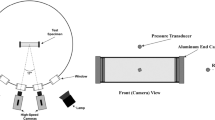Abstract
A comprehensive investigation on the implosion of composite cylinders subjected to a nearby explosion is performed. Experiments are conducted in a large pressure vessel, designed to provide constant hydrostatic pressure throughout the event. Carbon fiber/epoxy filament-wound tubes are studied with constant hydrostatic pressure and varying charge standoff distances to determine the effect of the explosive loading on the mechanisms of collapse. 3-D Digital Image Correlation (DIC) is used to capture the full-field displacements and velocities during the implosion event, and to characterize the initial dynamic response of the tube. Dynamic pressure transducers measure the shock waves generated by the explosive and also the pressure pulse generated by the collapse. Results show that different magnitudes of explosive loading produce drastic differences in the way implosions are initiated, and in the extent of damage to the structure. Experiments with strong explosive loading show immediate collapse of the tube upon the arrival of shock wave. Relatively smaller explosive loading result in collapses due to the additional bubble pulse loading, or after accumulating damage for extended periods of time.













Similar content being viewed by others
References
Mouritz AP, Gellert E, Burchill P, Challis K (2001) Review of advanced composite structures for naval ships and submarines. Compos Struct 53(1):21–42
Lindberg HE, Florence AL (1987) Dynamic pulse buckling: theory and experiment. M. Nijhoff, Dordrecht
Moon CJ, In-Hoon K, Bae-Hyeon C, Jin-Hwe K, Choi JH (2010) Buckling of filament-wound composite tubes subjected to hydrostatic pressure for underwater vehicle applications. Compos Struct 92(9):2241–251
Ross CTF, Little APF, Haidar Y, Waheeb AA (2009) Buckling of carbon/glass composite tubes under uniform external hydrostatic pressure. Strain 47:156–174
Smith PT, Ross CTF, Little APF (2009) Collapse of composite tubes under uniform external hydrostatic pressure. J Phys: Conf Ser 181:156–157
Hur SH, Son HJ, Kweon JH, Choi JH (2008) Postbuckling of composite tubes under external hydrostatic pressure. Compos Struct 86(1–3):114–24
Pinto M, Gupta S, Shukla A (2014) Study of implosion of carbon/epoxy composite hollow cylinders using 3-D digital image correlation. Compos Struct 119:272–286
Pinto M, Gupta S, Shukla A (2015) Hydrostatic implosion of GFRP composite tubes studied by digital image correlation. J Press Vess Technol 137(5):051302
Pegg NG (1994) Effects of impulse duration and combined impulse-hydrostatic pressure on buckling stability of cylindrical structures. J Ship Res 38(2):164–71
Tanov R, Tabiei A, Simitses G (1999) Effect of static preloading on the dynamic buckling of laminated cylinders under sudden pressure. Mech Adv Mater Struct 6(3):195–206
Krueger SR (2006) Simulation of cylinder implosion initiated by an underwater explosion. Naval Postgraduate School, Monterey
Hoo Fatt MS, Pothula SG (2010) Dynamic pulse buckling of composite shells subjected to external blast. Compos Struct 92(7):1716–727
Brett J, Yiannakopolous G (2008) A study of explosive effects in close proximity to a submerged cylinder. Int J Impact Eng 35(4):206–25
Hung CF, Lin BJ, Hwang-Fuu JJ, Hsu PY (2009) Dynamic response of cylindrical shell structures subjected to underwater explosion. Ocean Eng 36(8):564–77
Ikeda, CM (2012) Fluid–structure Interactions Implosions of Shell Structures and Wave Impact on a Flat Plate. Thesis. University of Maryland, College Park
Arora H, Hooper PA, Dear JP (2012) The effects of Air and underwater blast on composite sandwich panels and tubular laminate structures. Exp Mech 52:59–81
Sutton MA, Orteu JJ, Schreier HW (2009) Image correlation for shape, motion and deformation measurements: basic concepts, theory and applications. Springer, New York
Gupta S, Parameswaran V, Sutton MA, Shukla A (2014) A study of underwater implosion using digital image correlation. Proc R Soc A 470(2172):20140576
Turner SE, Ambrico JM (2012) Underwater implosion of cylindrical metal tubes. J Appl Mech 80(1):1–11
Ikeda CM, Wilkerling J, Duncan JH (2013) The implosion of cylindrical shell structures in a high-pressure water environment. Proc R Soc A: Math Phys Eng Sci 469:2160
Cole RH (1948) Underwater explosions. Princeton University, Princeton
Kinsler LE, Frey AR (1962) Fundamentals of acoustics. Wiley, New York
Sridharan S (2008) Delamination behaviour of composites. Woodhead, Cambridge
Shin YS (2004) Ship shock modeling and simulation for far-field underwater explosion. Comput Struct 82(23–26):2211–219
Acknowledgments
The authors would like to acknowledge the Office of Naval Research and Dr. Yapa D.S. Rajapakse for providing financial support to conduct this research under Grant No. N00014-10-1-0662.
Author information
Authors and Affiliations
Corresponding author
Rights and permissions
About this article
Cite this article
Pinto, M., Shukla, A. Shock-Initiated Buckling of Carbon/Epoxy Composite Tubes at Sub-Critical Pressures. Exp Mech 56, 583–594 (2016). https://doi.org/10.1007/s11340-015-0033-1
Received:
Accepted:
Published:
Issue Date:
DOI: https://doi.org/10.1007/s11340-015-0033-1




